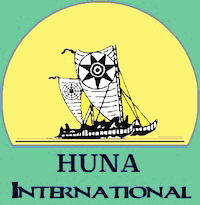Huna Article
Huna International
Here There Were Dragons
by Serge Kahili King
As isolated as they are, the Hawaiian Islands share one curious feature with Europe and Asia: all of them
have legends of dragons. Like their European and Asian counterparts, Hawaiian dragons are lizard-like, have
magical powers, can be good or bad, and often live in caves. Unlike the others, however, Hawaiian dragons do
not have wings, do not fly, and do not belch fire. Dragon stories are among the oldest in the islands.
The key word in Hawaiian is mo'o, which can mean a lizard, a reptile of any kind, a water spirit,
and even a scorpion. When describing a dragon, the form is usually mo'o nui, meaning "big lizard."
Interestingly, mo'o nui is also the word for crocodile. An alternate word for dragon is
kiha, which also means "sneeze" and could be translated as "life force." Hawaiian dragons are
almost always associated with water, usually near to or in the ocean.
One theory has it that mo'o nui originally referred to saltwater crocodiles. Although there are
currently no saltwater crocodiles in Polynesia (nor any snakes, either, for that matter), that may not have
always been the case. Saltwater crocodiles normally are found in India and Southeast Asia, but they are
known to be able to travel in the ocean for great distances and some have been found outside their normal
range as far into the South Pacific as Fiji. Hawaiian historian Samuel Kamakau, writing in the 1800s, said
that the guardian mo'o of fishponds were twelve to thirty feet long, which is also the reported
size range for saltwater crocodiles.
Nothing related to dragons is simple, however. In Europe, dragons are associated with Druids, and the
Druidic religion. In Hawaii, the legends associate dragons with sorcerers, and there were temples dedicated
to their worship.
Here are a few kinds of Hawaiian legends about mo'o nui:
A tale from Waimea Valley on Kauai about a girl whose parents do not have time to play
with her, so she goes to live with a friendly dragon who lives in a cave behind a waterfall.
Another tale from Kauai in which a beautiful half-dragon half-woman named Palai ("to hide away") lives in
the lower wet cave at Ha'ena and lures a local chief into the cave, has a baby by him, kills him, and then
disappears into the water of the cave forever when confronted by the local people.
A famous and complicated story from Puna on Big Island about a woman named Laieikawai (difficult to
translate, but carries the idea of living in the water) who is raised by a dragon relative called Waka
"serrated, spiky") and guarded by another dragon relative called Kihanuilulumoku ("forest protector
dragon").
Kihawahine ("female dragon") is a famous dragon of Maui and Kauai. On Oahu, Laniwahine ("royal or
heavenly female") was a prophesying dragon of Waialua, Kanekuaana ("man-carrying one") brought
prosperity to Ewa, and Hauwahine ("female to whom one prays") protected the poor and warded off illness
in the Ko'olau district, to name a few good dragons. Pi'ikalalau ("the one who goes astray in the
mountains") of Kauai, Laniloa ("large royal or heavenly one") of Oahu, and Panaewa ("the famous unjust
one") of Big Island were evil ones. Almost all dragons in all legends were female.
Many stories are told about the rivalry and conflict between Pele the volcano goddess, her sister
Hi'iaka, and various dragons on the different islands. Some authors consider this as a family rivalry
and others as a religious conflict. Perhaps the most famous instance is when Pele has manifested in
human form on Kauai to win the affections of the chief Lohiau. During her stay, Pele is challenged by
Lohiau's mo'o nui sister, Kilinoe ("misty rain"), to a wind-naming contest which includes the
ability to call up each wind named. Pele wins the contest and Kilinoe is later turned into a stone by
Hi'iaka. We know the story is true, because you can still see the stone of Kilinoe near Ke'e Beach on
Kauai's North Shore.
Author's Note: The translations of the names are by me. Other translations are possible.
Copyright Huna International 2018

|

